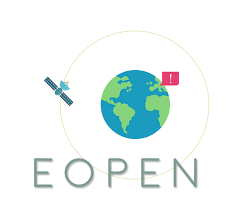- Points of Contact:
- M. Gabriella Scarpino (Project Coordination Team)
- Stefanos Vrochidis (Technical Manager)
- Leslie Gale (Project Innovation Manager)
- Bernard Valentin (Platform Development and Integration Leader)
The EOPEN project, coordinated by Serco, ended successfully in October 2020: it exploits ONDA for Sentinel data access and, more generally, it provides a platform to develop and deliver EO data rich services removing the need and cost to create and maintain an infrastructure for systematically processing user defined workflows.
Its legacy and perspective exploitation are briefly presented in this showcase, prepared in cooperation with Space Application Services, (Leslie Gale, Project Innovation Manager and Bernard Valentin, Platform Development and Integration Leader).
Have a look at it and at the EOPEN – ONDA Service Offer – for any query, please refer to the above contacts.
EOPEN acronym stands for “opEn interOperable Platform for unified access and analysis of Earth observatioN data”. As its name suggests, EOPEN is an open platform, with capabilities to fuse Sentinel data with multiple, heterogeneous and other Big Data sources. EOPEN is agnostic of both the programming language of the algorithms and the platform in which processes are running (federated platforms execution framework) and is capable of integrating algorithms from service developers, consumers of the services – for instance when specific display requirements are needed –, and third parties who provide domain specific applications such as the extraction of information from social media.
The EOPEN platform has been designed having the needs of use case stakeholders/end users firmly in mind, along with researchers developing a set of software and applications which can be run on different platforms, thus tackling interoperability.
In addition to Sentinel data accessed through an Umbrella Hub (*) (running e.g. on a ONDA-DIAS machine), other Copernicus data, either EO or non-EO, are available on the platform and can thus be exploited for implementing other applications.
To demonstrate the capabilities of EOPEN three Use Cases have been implemented during the project, namely: flood risk assessment, food security and climate change mitigation.
Read further for an introduction to the platform and to find out more about the project on EOPEN Project website.
(*) A DHuS independent interface to access Sentinel data.
How EOPEN works
Two Introductory videos illustrating the visualization component (dashboards) and the developer interface can be accessed here – a link to a survey for collecting feedback is also available.
Platform access
- An example of dashboard access (GIS viewer) for the visualization of some layers is provided here.
Access to user dashboards and the developer portal requires authorisation. To get an account on EOPEN please contact us – requests can be considered especially if related to service implementation or any project activities.
- Reference Guides for users and developers are also available from the platform here.
Hints on the data component and visualization
Some global datasets which can be accessed from the platform are listed below.
Weather data, Copernicus Climate data and Copernicus Land Service Products
| Product/Information Layers | Coverage |
| Weather forecast HIRLAM (54 Hours) | Europe |
| Copernicus Climate Data Store | Global |
| NASA POWER product | Global |
| SMOS Level 3 Freeze/Thaw service | Northern hemisphere |
Based on the above data products, some information layers have been implemented, as needed in the Use Cases – e.g. the HIRLAM Cumulated Precipitation Forecast layer for PUC1 (update frequency: 6-24 hours) linked to alert email notifications in case given precipitation amounts are exceeded at municipality level.
Information layers can be visualized by selecting “Dashboards/GIS Viewer” from the EOPEN User Portal, then by clicking on +Add Data, layers can be selected from the EOPEN GeoServer showcase. Note that for visualizing a layer the corresponding date range must be set as well as a suitable style (ref. EOPEN User Guide).
Some information about the layers implemented for the Use Cases is available in the training material here.
Some dashboards for social media data (i.e. Tweets) visualization have been implemented, related to the Use case topics; for example the “Social media” dashboard allows to filter and display tweets by topic (flood events, snow cover and food security) in a given date range, in addition to other options (e.g. tweets containing an image).
Also, the dashboard “Linked data” allows to visualize Tweets over a specified area and date range (e.g. Italy in the period 1-15 December 2020).









